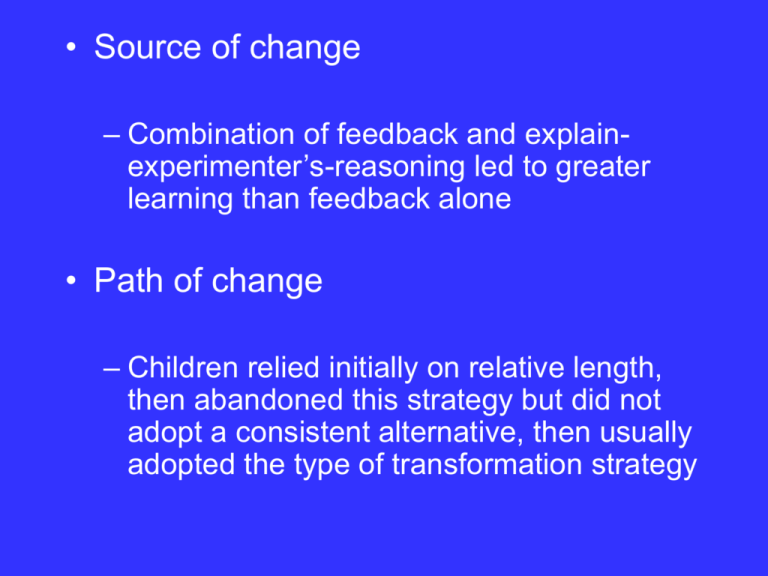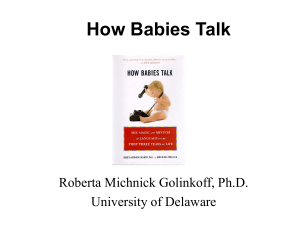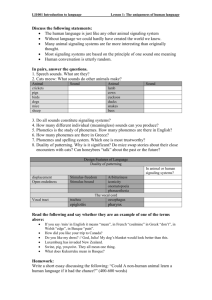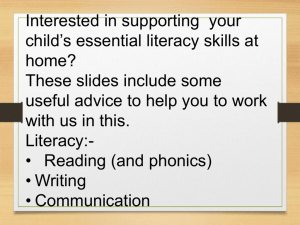word order - People Server at UNCW
advertisement

• Source of change – Combination of feedback and explainexperimenter’s-reasoning led to greater learning than feedback alone • Path of change – Children relied initially on relative length, then abandoned this strategy but did not adopt a consistent alternative, then usually adopted the type of transformation strategy • Rate of Change – Most children required multiple sessions to progress from initial use to consistent use of the transformation strategy • Breadth of Change – Relatively narrow (low generalizability) • Even some of the best learners continued in the final session to offer relative length explanations (rather than transformational explanations) when the longer row also had more objects • Variability of change – Substantial variability within and between children • Within children: Only 2% of children relied on a single strategy throughout the study; 70% used three or more strategies • Between children: Individual differences in learning could be predicted by two pretest measures (total number of strategies used, whether two strategies were ever used on the same problem) Cognitive Development (Re-cap) • Current state of the field is characterized by multiple theoretical perspectives • In some cases, these perspectives attempt to explain the same phenomena (e.g., object understanding from a Piagetian versus a core-knowledge perspective; development of number conservation from a Piagetian or information processing approach) • Often, theoretical perspectives address different aspects of cognitive development – Therefore, the extent to which they are compatible or contradictory remains unclear and their explanatory value is difficult to evaluate – Researchers have called for greater unification of theoretical perspectives Types of Language Development • Phonological Development – Learning the sound system of a language • Phoneme: Smallest meaningful unit of sound in a language – Ex: “rake” and “lake” differ by one phoneme (/r/ versus /l/) – Includes: • Distinguishing the basic phonemes of a language and segmenting the flow of speech into words (auditory development) • Producing sounds (articulatory development) • Semantic (Lexical) Development – Word learning • Learning the meaning of words • Syntactic (Grammatical) Development – Learning the system of rules for combining words in a language – Ex: English—many rules related to word order » Subject-verb-object » “Mary loves John” versus “John loves Mary” • Pragmatic Development – Learning the skills needed to maintain communication and conversation • Conversations typically involve a greeting, turntaking, and a shared topic • Adjusting content of communications to match listener’s interests, knowledge, and language ability Precursors to Language (Phonological Dev.) • Categorical Perception – Adults distinguish speech sounds (phonemes) categorically • Ex: /b/ and /p/ are on an acoustic continuum – The only difference between them is the length of time between when air passes through the lips and when the vocal cords start vibrating (voice onset time or VOT) • Adults do not perceive the continuous nature of sounds • Ex: Sounds with a VOT of less than 25 ms are perceived as /b/ and those greater than 25 ms are perceived as /p/ • Divide a continuous signal into two discontinuous categories • Infants also show categorical perception Eimas, Siqueland, Jusczyk, & Vigorito (1971) • 1- and 4-month-olds heard speech sounds contingent on their sucking • One group was habituated to /ba/ and the other group was habituated to /pa/ • Test trials: – Voice onset time equated across conditions • /ba/ group heard a sound adults perceive as /pa/ (VOT = 20 ms for /ba/ and 40 for /pa/) • /pa/ group heard a sound adults perceive as /pa/ (VOT = 60 and 80 ms respectively) • Infants in the first group dishabituated, while infants in the second group did not • Young infants can initially distinguish phonemes in all the languages of the world • By 1 year of age, lose the ability to discriminate speech sounds that are not used in their native language – Ex: English-speaking infants up to 6-8 months olds can distinguish phonemes used in Hindi but not in English; at 12 months, cannot • Individual differences in the timing of infants’ loss of sensitivity to phonemes not used in their native languages – For some infants, begins as early as 7 months – Earlier “loss” is related to better performance on vocabulary and grammar tests between 14-30 months of age Babbling • Between approximately 2-3 months, infants begin “cooing” – Simple speech sounds (“oohh”, “aaahh”, “goo”) • Between approximately 6-10 months, “babbling” begins – Syllables made up of a consonant followed by a vowel (“ba”, “pa”) that are repeated First Words • Infants show comprehension of words before they produce them – By 12 months, may know as many as 10 words Semantic (Lexical) Development • How do children learn what words mean? – Quine’s problem: “Gavagai” • “Shoot now” or “There’s a rhino” or “It got away” • If it refers to the rhino, does it mean the whole rhino or one of its parts? • What cues do children use to link words with their referents? Cues to Word Meaning: – Gestures: Eye gazes, pointing, other movements • Children use direction of gaze to learn word meaning • Similarly, sensitive to gestures or movements – Speaker’s apparent intention • If children cannot see what the speaker is looking at, may fail to learn new words • If an unintentional action is associated with a new word, children don’t associate that action with the word • Whole-Object Assumption – Expectation that a novel word refers to a whole object (rather than a part or other aspect of the object) • Ex: “Cat” refers to whole cat, not its whiskers or other parts – Markman: innate constraint on meanings children entertain for new words – MacWhinney: children learn that objects typically function as perceptual wholes, but also realize that this assumption can be wrong • Ex: couch • Mutual Exclusivity or Competition? • Markman proposes that there is an innate constraint on early word learning (mutual exclusivity assumption) – An object can have only one name • MacWhinney argues that if mutual exclusivity were an important constraint on word learning, children should often reject a new name for a familiar object – Few children show this tendency – Also, almost every object has more than one name (so mutual exclusivity is violated constantly) • Same argument for bilingual children – If mutual exclusivity is a strong constraint, how do children learn that EVERY object has two different labels? • So MacWhinney argues that in studies where a new object is presented with a new word, child will assume the new word refers to the new object (trying to establish a “semantic niche” for each word) – But in the real world, children learn that objects can be referred to using multiple different words • In general, MacWhinney argues that early word meanings include a lot of detail (much of it irrelevant), which is then gradually pruned as the result of experience • Initial referent for a word is highly specific to the initial context of exposure – Specificity leads to undergeneralization








